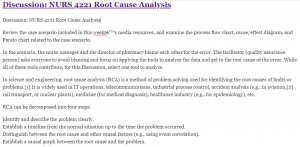Discussion: NURS 4221 Root Cause Analysis
Discussion: NURS 4221 Root Cause Analysis
Review the case scenario included in this week’s media resources, and examine the process flow chart, cause/effect diagram, and Pareto chart related to the case scenario.
In the scenario, the nurse manager and the director of pharmacy blame each other for the error. The facilitator (quality assurance person) asks everyone to avoid blaming and focus on applying the tools to analyze the data and get to the root cause of the error. While all of these tools contribute, for this Discussion, select one tool to analyze.
In science and engineering, root cause analysis (RCA) is a method of problem solving used for identifying the root causes of faults or problems.[1] It is widely used in IT operations, telecommunications, industrial process control, accident analysis (e.g., in aviation,[2] rail transport, or nuclear plants), medicine (for medical diagnosis), healthcare industry (e.g., for epidemiology), etc.
RCA can be decomposed into four steps:
Identify and describe the problem clearly.
Establish a timeline from the normal situation up to the time the problem occurred.
Distinguish between the root cause and other causal factors (e.g., using event correlation).
Establish a causal graph between the root cause and the problem.
RCA generally serves as input to a remediation process whereby corrective actions are taken to prevent the problem from reoccurring. The name of this process varies from one application domain to another. According to ISO/IEC 31010, RCA may include the techniques Five whys, Failure mode and effects analysis (FMEA), Fault tree analysis, Ishikawa diagram and Pareto analysis.
Definitions
In science and engineering, there are essentially two ways of repairing faults and solving problems.
Reactive management consists in reacting quickly after the problem occurs, by treating the symptoms. This type of management is implemented by reactive systems,[3][4] self-adaptive systems,[5] self-organized systems, and complex adaptive systems. The goal here is to react quickly and alleviate the effects of the problem as soon as possible.
Proactive management, conversely, consists in preventing problems from occurring. Many techniques can be used for this purpose, ranging from good practices in design to analyzing in detail problems that have already occurred, and taking actions to make sure they never reoccur. Speed is not as important here as the accuracy and precision of the diagnosis. The focus is on addressing the real cause of the problem rather than its effects.
Root-cause analysis is often used in proactive management to identify the root cause of a problem, that is, the factor that was the main cause of that problem.

Discussion: NURS 4221 Root Cause Analysis
It is customary to refer to the root cause in singular form, but one or several factors may in fact constitute the root cause(s) of the problem under study.
A factor is considered the root cause of a problem if removing it prevents the problem from recurring. A causal factor, conversely, is one that affects an event’s outcome, but is not the root cause. Although removing a causal factor can benefit an outcome, it does not prevent its recurrence with certainty.
Examples
Imagine an investigation into a machine that stopped because it overloaded and the fuse blew.[6] Investigation shows that the machine overloaded because it had a bearing that wasn’t being sufficiently lubricated. The investigation proceeds further and finds that the automatic lubrication mechanism had a pump which was not pumping sufficiently, hence the lack of lubrication. Investigation of the pump shows that it has a worn shaft. Investigation of why the shaft was worn discovers that there isn’t an adequate mechanism to prevent metal scrap getting into the pump. This enabled scrap to get into the pump, and damage it.
The apparent root cause of the problem is therefore that metal scrap can contaminate the lubrication system. Fixing this problem ought to prevent the whole sequence of events recurring. The real root cause could be a design issue if there is no filter to prevent the metal scrap getting into the system. Or if it has a filter that was blocked due to lack of routine inspection, then the real root cause is a maintenance issue.
Compare this with an investigation that does not find the root cause: replacing the fuse, the bearing, or the lubrication pump will probably allow the machine to go back into operation for a while. But there is a risk that the problem will simply recur, until the root cause is dealt with.
Cost benefit analysis
The above doesn’t include cost/benefit analysis: does the cost of replacing one or more machines, to have a filter, exceed the cost of downtime until the fuse is replaced. This situation is sometimes referred to as the cure being worse than the disease.[7][8] An unrelated lack of cost/benefit analysis, which can help explain the problem of the cure being worse than the disease, is the tradeoff between some claimed benefits of population decline, which in the short term provides fewer payers into pension/retirement systems, versus halting the population declines while conceding the need for higher taxes to cover the cost of building more schools.
Do you need a similar assignment written for you from scratch? We have qualified writers to help you.
You can rest assured of an A+ quality paper that is plagiarism free. Order now for a FREE first Assignment!
Use Discount Code "FREE" for a 100% Discount!
NB: We do not resell papers. Upon ordering, we write an original paper exclusively for you.

